Equipment:
- Braun Multimag SlideScan 4000 Diascanner (discontinued)
- Round 100-Slide Carousel
- 17″ MacBook Pro Late-2011 4-Core running Lion
- 17″ MacBook Pro Pre-Unibody 2.16GHz Core Duo running Snow Leopard
- Vuescan 9x 32-bit (9.0.79) (I tried the 64-bit version but it’s not compatible with my HP Scanner so I already had this one installed). Details on its support of the Braun Multimag SlideScan 4000 can be found here.
- Adobe Photoshop CS4 (11.0.2)
Here is an example of the quality scan I could get from 40+ year old slides.
I have written a report about the successor to this scanner, the Pacific Image PowerSlide 5000:
How to Scan Slides on a Pacific Image PowerSlide 5000 With VueScan on a Mac
This is not exactly a fix-it post but there will be a bunch of trouble-shooting none-the-less so I figured I’d document how things go when I attempt to scan the ~3,000 slides my father took back in the 60’s and 70’s. I had scanned a few slide singles with the HP Scanjet 4850 scanner I had but it took forever and it was not practical to try to scan any large amount of slides with it going four at a time. I researched automatic slide scanners and the most popular models I found were both from Pacific Image: Pacific Image PowerSlide Series 3650 (PS3650) and Pacific Image PowerSlide Series 5000 (PS5000). Another scanner is the Nikon Super CoolScan 5000 ED Film Scanner but it is VERY expensive AND it requires a $470 adapter
to automate the scanning.
After doing a lot of googling I discovered that the Pacific Image PowerSlide has been rebranded and you can buy the same scanner under a different brand for a lower price. Braun Multimag SlideScan 4000 is virtually the same as the PowerSlide 3650, they are just stamped with different brands. The reason I picked the Multimag is because I was able to get a used one for $500 on ebay versus the higher price the PowerSlide is going for (comparing used to used). Another identical scanner is the Reflecta DigitDia 5000.
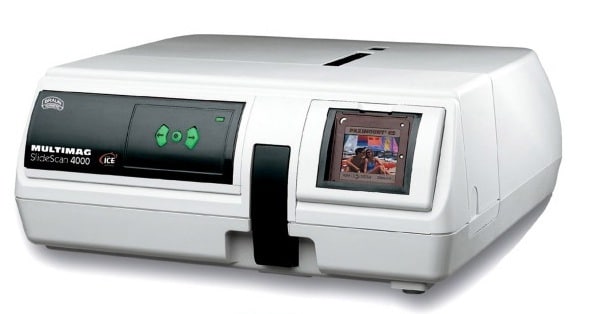 |
| Braun Multimag SlideScan 4000 |
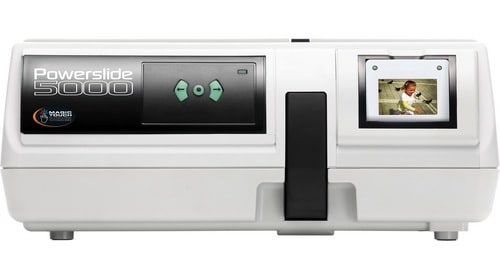 |
| Pacific Image Powerslide 5000 (the newer version of the 3650, which still looks just like the Braun) |
The scanner arrived and the first issue I ran into was getting VueScan to recognize the scanner on my MacBook. I tried installing the Cyberview X5 drivers from here. Once I got that software to recognize the scanner I was able to get VueScan to work on both my OS 10.7 and 10.6 machines, which they are not saying is possible.I started scanning using the Paximat 50-slide magazine that came with the scanner and the first thing I ran into were some auto-crop issues where VueScan would not center the crop on the image. The whole image would be scanned but for some reason VueScan would not offset its crop and trim off the top edge of the slide. Since I’m doing archiving scans that is not going to work. After playing around with that I decided to just have it scan the maximum area and crop them by hand when I go through and edit them. I contacted VueScan’s author, Ed Hamrick, who is real responsive to questions, and he is interacting with me over why VueScan is not cropping correctly. To avoid dealing with that issue I just set the crop setting to maximum and plan to crop them by hand afterwards.The next issue I ran into using the 50-slide magazine was that somehow the slide was not parked in the right place when it was being scanned and part of the slide was not being scanned. After looking more carefully at the scanners action I discovered the reason was that the tappet, i.e. the long thin silver bar that feeds the slides into the scanner, was slipping off the edge of the slide and therefore not pushing it all the way into the scanner. I researched this issue and there are definitely others who have had this problem. Pacific Image addresses this problem on their FAQ page here. It is really unclear how much pressure they want you to put on the tappet to pull it in the direction it needs to be to center on the slide. I didn’t feel like they want you to bend it so it’s a bit confusing. I have a tech support email out to them inquiring about this. I’ll update the post if I hear something back.
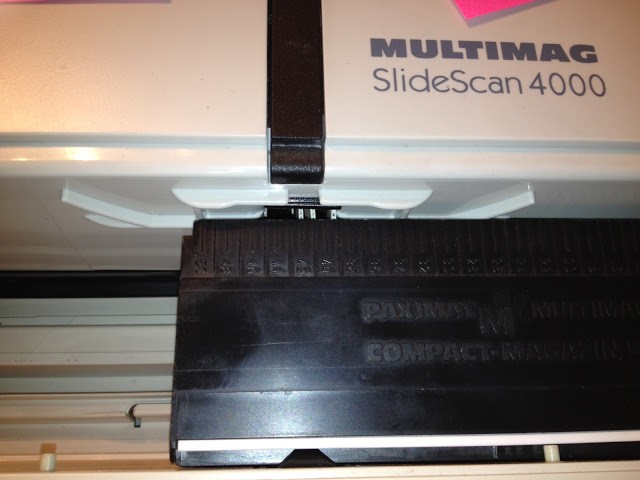 |
| 50-Slide magazine Jam (see the white edges of the 3 protruding slides) |
I ran into an issue with the 50-slide magazine jamming when I left it running overnight. I came downstairs to find the machine stopped in the middle of the magazine. It’s real difficult to see what is going on with jams on this machine because everything is inside. From what it appeared, 2 slides were shoved into the same slot (where one slot won’t fit 2 slides). I tried to push the slide back into the scanner using a tweezers but I could not. It seemed that the top was in farther than the bottom and I couldn’t push in the bottom of the slide with the tweezers–the space is too tight. I then tried to use a steak knife from the side trying to (carefully) stab the side of the slide’s cardboard frame and leaver it back in. I had some success getting the slide to move but still wasn’t able to get it to go all the way in.
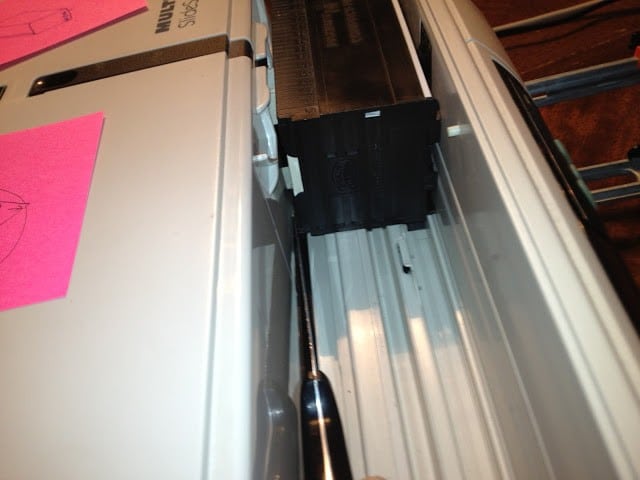 |
| Slide Scanner surgery, steak knife style |
Eventually I got one of the 2 slides to go back in and just forced the magazine out of the way, bending the edge of the remaining slide in the process. I then discovered that the issue was that the scanner had pushed the slide onto the magazine’s divider and the cardboard had split, with one side of it on either side:
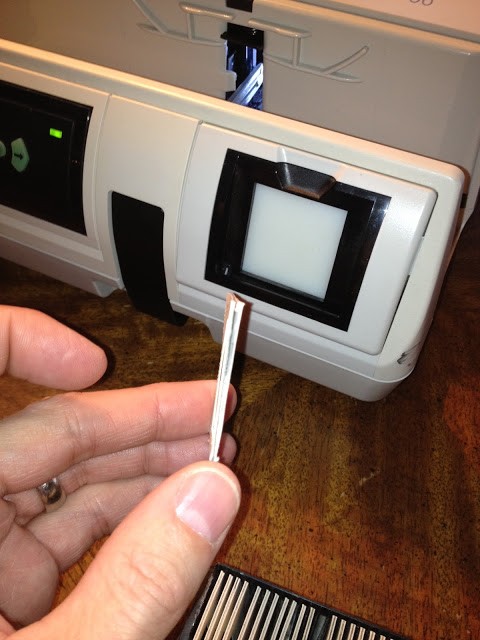 |
| Slide split in half |
I had some problems with the scanner jamming in that it was having a problem ejecting the slide. It wasn’t that it was hitting something when it was trying to push the slide into the magazine (which I had that problem at different times) but that it wasn’t even getting started. There is a little spring-loaded lever that pushes down on the top of the slide when it is inside the scanner. What was happening is that after the slide was inserted into the scanner it was not being allowed to come all the way down but was sitting on the top of the 50-slide magazine. This would cause the slide to rock forward when the arm tried to push it out and therefore causing it to bind up inside the scanner.
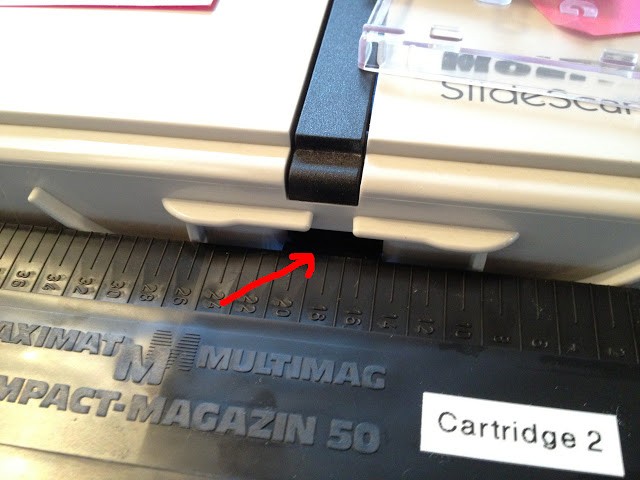 |
| The red arrow points to the black part that was getting caught on the top of the 50-slide magazine when the slide would be inserted into the scanner |
In order to fix this issue I taped some cardboard onto the scanner which would put some more space between the scanner body and the 50-slide magazine and then never had an issue with it again. Here’s my fix:
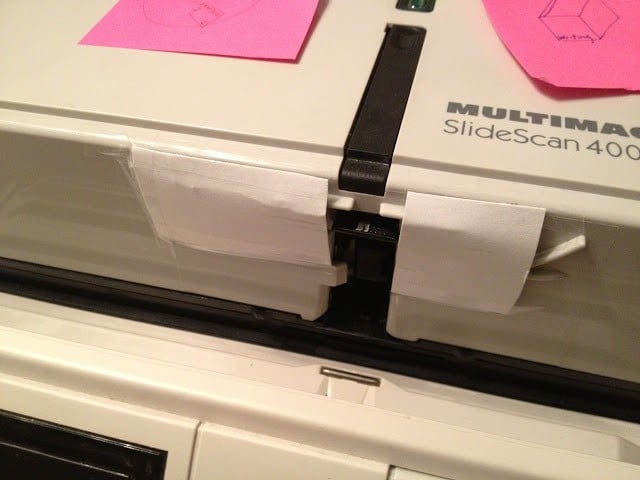 |
| My cardboard spacer to hold the cartridge away from the scanner (and the black slide arm on the top) |
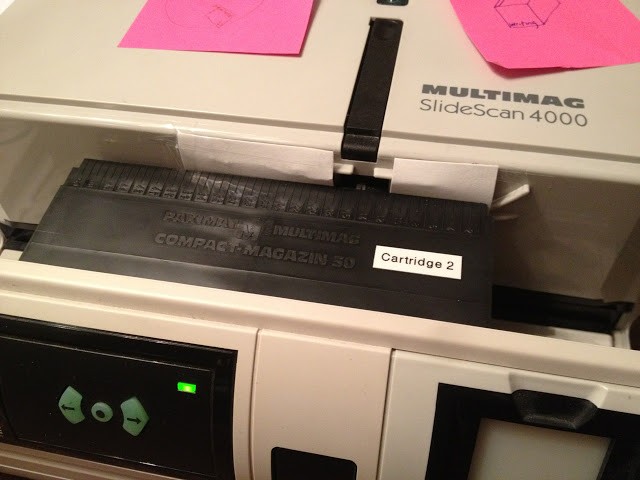 |
| With the cartridge installed. |
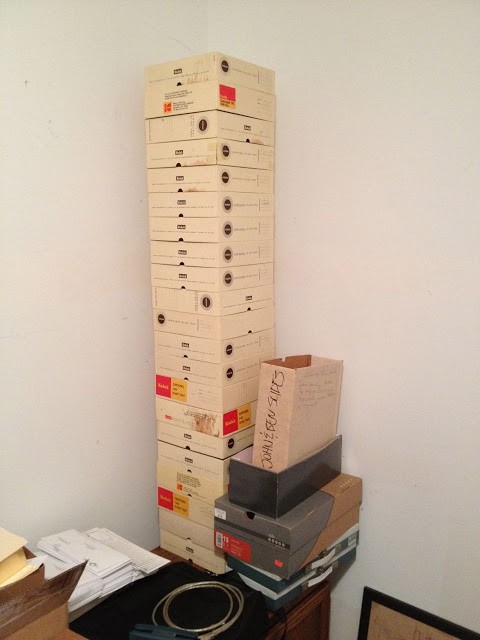 |
| My mountain of 3,000+ slides to scan |
Here’s some of my father’s slides that I scanned as they appear in a facebook album I posted them to:
 |
| Slides my father took in Viet Nam (Facebook crops them square to preview) |
All my film/negative scanning posts:
- How to Archive and Store 35-mm Slides
- How to Fix Braun Paximat Multimag Compact Magazine Jamming on Slide Number 25
- How to Scan Slides on a Pacific Image PowerSlide 5000 With VueScan on a Mac
- How to Scan Odd-Sized Negatives on an Epson Perfection V700 Scanner Model J221A
- How to Scan Odd-Size Negatives on a HP Scanjet 4850
- Scanning Slides With a Braun Multimag SlideScan 4000 Diascanner, same as Pacific Image ProSlide 3650 (this post)
Some slide-scanning tutorials I found helpful:
Amazon Associate Disclosure: As an Amazon Associate I earn from qualifying purchases. This means if you click on an affiliate link and purchase the item, I will receive an affiliate commission. The price of the item is the same whether it is an affiliate link or not. Regardless, I only recommend products or services I believe will add value to Share Your Repair readers. By using the affiliate links, you are helping support Share Your Repair, and I genuinely appreciate your support.

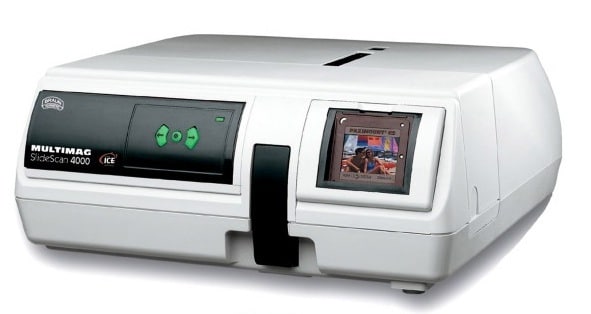
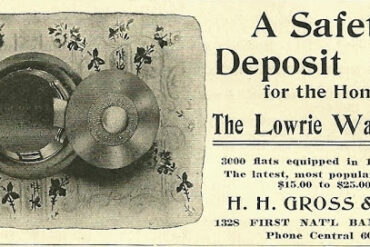
1. Thank you for the in-depth analysis of using this device. Our office is considering buying one for similar large projects and I was wondering if you experienced any permanent failures of the device along the way?
2. I'm just curious if your father was an engineer in Vietnam? I work for the US Army Corps of Engineers history office and we rarely see good images of engineer projects in Vietnam, but it appears your father had some good ones, and well-labeled ones too – just from the small snipets you've posted. I was wondering if you'd be interested in talking about some of those further?
Hey James, thank you for your comment. I have not heard of failures of this scanner or its predecessor, which I owned as well. I've heard of people scanning over 10,000 slides with them. I scanned over 3,000 with the previous model and it was used. The one I write about in this article was used too and I have scanned 1,600+ slides with it. My father was an image interpreter in the Army but his father ran a construction business back home in Kansas (Readi-mixed concrete) that my dad was working at when he went off to Viet Nam–that is why he was interested in construction when he saw it and wanted to take pictures. If you would like to discuss this more via email please respond to this comment with only your email address and I'll respond that way but not publish the comment (and therefore your email address will not be made public).
Oh, James, I didn't realize you were commenting on my first post, of the Braun Multimag SlideScan 4000 Diascanner (same as Pacific Image ProSlide 3650) because I just published a large write-up on its successor, the Pacific Image 5000. My reply was written thinking that you were replying to that post since it was so fresh in my mind. None-the-less I'd love to help in any way I can and please post a comment with your email and I will email you back but not publish the comment and thus make your email public (I have so many people publishing spam product links to my blog that I have it set that I must approve anything before it gets published).
Have you compared your results to that of commercially scanned slides (.e.g. Costco or elsewhere)?
I know slide scans never have the intensity of the original slide, but how would you rate the quality of the scans (sharpness, color, etc.)
I really am not that familiar with how these slides should have looked so I can't really say how they compare. I didn't have any professional company do any for me because it just wasn't an option to use them since I really needed to keep track of the notes on the box and convey as much information about the slide to the digital image since I didn't take these pictures. I scanned them at the highest resolution this scanner would do (taking about 90 seconds/slide) and I was VERY pleased with the results. That would give me about around a 10 meg cropped jpeg file. The image linked below (original size) is 10 Meg and 4,858×3210.
https://www.dropbox.com/s/lo6zc89bwdewwf7/Example%20Slide%20Scan.jpg